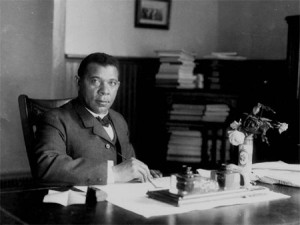 In the fall of 1872, a 16-year-old African American with little more than the tattered clothes on his back arrived in Hampton, Virginia, hoping to enroll in Hampton Normal and Agricultural Institute, now Hampton University. Initially turned away, he would become Hampton’s most famous graduate. Born a slave in Hale’s Ford, Virginia, Booker T. Washington had experienced the Civil War and seen the evils of slavery firsthand. The Emancipation Proclamation in 1863 and the 13th Amendment that officially abolished slavery in 1865 provided inspiration and the opportunity for the inquisitive, intelligent and hard-working Washington to seek a higher education.
In the fall of 1872, a 16-year-old African American with little more than the tattered clothes on his back arrived in Hampton, Virginia, hoping to enroll in Hampton Normal and Agricultural Institute, now Hampton University. Initially turned away, he would become Hampton’s most famous graduate. Born a slave in Hale’s Ford, Virginia, Booker T. Washington had experienced the Civil War and seen the evils of slavery firsthand. The Emancipation Proclamation in 1863 and the 13th Amendment that officially abolished slavery in 1865 provided inspiration and the opportunity for the inquisitive, intelligent and hard-working Washington to seek a higher education.
Washington recalled in his book Up From Slavery that his stepfather, Ferguson Washington, had escaped slavery during the Civil War “…by running away and following the Federal soldiers…” Historian Michael Rudolph West concludes in his book The Education of Booker T. Washington, that Ferguson Washington indeed sought refuge from slavery by becoming a Union Contraband of War. He traveled with the Union army from Virginia to West Virginia and ultimately settled there after the War.
Following the Civil War, while working as a coal miner deep within the mountains of West Virginia, the young Booker T. Washington overheard whispers from other workers about a school for African Americans somewhere in Virginia. He saved what money he could, asked for help and eventually set out on his journey east, determined to reach the Hampton Normal and Agricultural Institute. He traveled over 500 miles, mostly on foot, sleeping wherever he could and essentially living off the land. Washington’s determination to reach Hampton was similar to his stepfather’s earlier struggle for freedom and opportunity, or for that matter, comparable to the perseverance of the tens of thousands of African Americans who risked their lives to seek refuge as Contrabands during the Civil War.
After completing his first year of schooling, Washington did not have enough money to travel home for the summer or pay his next year’s tuition. He was in desperate need of a job and looked throughout Hampton for employment. Washington recalled in Up From Slavery, that “After trying for several days in and near the town of Hampton, I finally secured work in a restaurant at Fortress Monroe.” He continues, “At night, and between meals, I found considerable time for study and reading; and in this direction I improved myself very much during the summer.” The restaurant in which Washington worked was likely the Hygeia Dining Saloon and was located directly beside the Baltimore Wharf within present day Continental Park at the terminus of Ingalls Road. Although no remnants remain of the restaurant or Wharf, a historic photograph and an 1873 map included in the Casemate Museum’s archives, provide a unique opportunity to step back in time. Looking at the photograph allows us to reflect and imagine the influence Fort Monroe may have had on the young Booker T. Washington. We can still walk in his footsteps as he worked his way through his school years. Washington graduated from Hampton with honors in 1875.
Fort Monroe, located at Old Point Comfort, Virginia, is a site that encapsulates the African American struggle for freedom. From the first documented Africans to arrive in English North America in 1619 to the heroics of the three slaves who escaped and became Contrabands of War in 1861, Fort Monroe at Old Point Comfort is an epicenter for African American history. Anthony and Isabella, William Tucker, Frank Baker, James Townsend, Sheppard Mallory, Mary Peake, Harriet Tubman and Booker T. Washington are just a few of the African Americans whose heroism can be traced directly to Fort Monroe at Old Point Comfort, the largest stone Fort in North America and a shining beacon for freedom.
Following his time at Hampton, Booker T. Washington became nationally acclaimed as an orator, author of 14 books, advisor to Presidents of the United States and the first teacher at the Tuskegee Normal and Industrial Institute, eventually becoming the principal. He held this position from 1881 until his death in 1915 at the young age of 59. This coming November 14th marks the 99th anniversary of his death and provides an opportunity to remember him as a great American and true champion of education and freedom.
Written by Robert Kelly, Casemate Museum Historian





